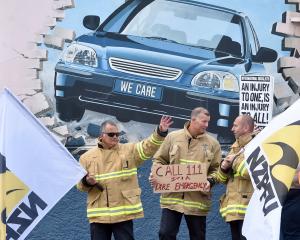He was busy then with the arrival of TV but he is as busy as he has ever been right now as thousands of Dunedin viewers realise they are not prepared for the digital switch in April.
''The way it is working out at the moment, I don't see how it is going to drop off once the change over comes around. I am thinking of taking a holiday.''
He was thinking of retiring next year but he has so many dazed customers that he is reluctant to leave them in the lurch.
He said many people had at least one TV or a set top box that would get digital TV but the quality of their viewing would depend on a range of factors, including how old their UHF aerial was.
''There is so much confusion, people don't know what to do.''
Mr Griffiths said he could not leave the house these days without fielding questions about people's digital needs.
''When I walk up the street I have to take a notebook with me.
''The bottom line is you have to have an aerial or a dish and it needs to be wired up to each TV and it has got to be wired up properly.''
While most people realised they needed a UHF aerial or a satellite dish and a digital receiver box or Freeview-capable TV, there were other things that people did not realise.
He said people were buying new high definition (HD) televisions and still finding they did not work properly.
The reason was often because people had old UHF aerials, purchased more than five years ago when HD was not a common feature of TVs. As a result their picture was still not very sharp.
The other reason was that some of the cheaper set top boxes did not produce true HD quality pictures.
Indoor UHF aerials were also unlikely to produce a very good picture and people needed to understand that they would need a proper aerial, with the necessary gain, depending on their area.
Back in the late 1960s and '70s it was no walk in the park either.
''We were doing big telescopic poles, 50 feet high and I wasn't too keen on those.
''I remember this big guy telling me once to get up the pole or you will be walking home.''
When satellite dishes came about, it was a big learning curve, too, and Mr Griffiths said he and his technician spent a lot of time scratching their heads at the time.
''By the time TV3 came along I was working for myself. I had a sign on the back of the van saying `are you ready for TV3'. When Prime came along I had the Prime logo and `Are you ready for Prime'. I got into trouble for using the Prime logo.''
Mr Griffiths' tip for people buying a new TV was to check they had a good UHF aerial to make use of the sharper pictures on offer.
Satellite dishes could be used in poor reception areas but had limitations when it came to using the new features on smart TVs . Mr Griffiths said a UHF aerial would give a superior quality image than satellite.
He said he saw a well-known presenter in the flesh recently and was surprised how different he looked after watching him on his satellite-fed TV at Ravensbourne.
''I was used to seeing him with a beachball head and a squat body because that is what satellite does.''
Mr Griffiths said he was enjoying the new HD TVs and the quality of the signals but he was holding off on buying a smart TV until he saw what the next round of developments would be.














